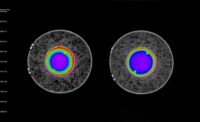
Videoscopes use camera chips and electronic image signals that can display a high-definition image on a video monitor. Source: Machida
The past 35 years have witnessed an almost explosive growth in the need for NDT/RVI (non-destructive testing/remote viewing inspections). Visual inspection, the most basic method of non-destructive testing, has seen amazing technological advances. The primary problem encountered with visual evaluation has always involved the limits of accessibility to the inspection areas. Industrial borescopes help fill this need. Borescopes allow for an internal inspection without disassembly, saving time and money.

Originally designed to meet the needs of the aviation industry, an industrial borescope provides video inspection of the inside of a Pratt & Whitney jet engine. Source: Machida
History of Borescopes
Originally designed to meet the needs of the aviation industry, industrial borescopes are now used in a variety of applications. These applications include aviation, aerospace, sanitation, automotive, weaponry, casting, law enforcement, electronics, refining and power generation. To meet the needs of the individual industries, these scopes come in an assortment of diameters and working lengths. They can be customized with side-view adapters, battery packs, outer coverings and working channel tools.Fiber Optic Borescopes vs. Videoscopes
There are two different types of borescopes–fiberoptic and video. Both are used to view objects that are not accessible for direct viewing. By illuminating an object and relaying a magnified optical image to an eyepiece or video processor, the viewer is able to see the inside of the object. Fiberoptic borescopes use bundles of fibers and objective lenses surrounded by optical systems that provide light. Videoscopes use camera chips and electronic image signals. A videoscope provides a much better image. Depending on the model, these images can even be displayed in high-definition on a video monitor.Videoscopes
A video borescope, or videoscope, is the 21st century’s response to the increased need for advanced remote visual inspection. Originally, the smallest videoscopes had 10mm outer diameters. Today, videoscopes as small as 2mm are being manufactured with the same, if not better, images. This advance in technology has helped inspectors to access areas that previously required costly disassembly.Videoscopes offer many advantages that, overall, save inspectors time and improve the quality of the inspection, saving companies money. Wider fields of view, clear images, easier recording capabilities and multiple-person viewing are just a few benefits of videoscopes. As the technology becomes more easily available, the scopes are decreasing in price and offering more and more options.
Videos and still images can be stored on SD-cards or directly on laptops, supplying a record of the inspection. Software is available to help quickly and efficiently generate inspection reports.
The inspection area is illuminated, often with specialized LEDs. Law enforcement scopes utilize ambient light so no light is emitted during the inspection. With an incredibly small CCD or CMOS chip embedded into the distal tip of the scope, the object is projected by an objective lens onto a sensor that produces an electronic image signal. This signal is transferred via a thin cable to an evaluation unit in which the signal is processed and made available as a standard signal, usually TV PAL or TV NTSC on a video monitor.
CMOS (complimentary metal-oxide semiconductor) technology is now used to create inexpensive scopes for use in homes, plumbing, and automotive. Pricing for these scopes ranges between $300 and $1,500 versus scopes utilizing CCD (charge-coupled device) chip technology that costs between $10,000 and $45,000. These higher end scopes are primarily for aviation, aerospace and power-generation applications. Features like high-resolution images, auto-focus, auto-light, picture-in-picture and measurement make these types of inspections much easier. Smaller technology also helps to decrease the size and weight, increasing portability.
Choosing the Right Videoscope
Choosing the right videoscope can often be difficult. With so much variety, it can often be overwhelming. When considering which videoscope to choose for which application it is important to consider the diameter, length, magnification, direction-of-view, field-of-view, and whether measurement, battery power, waterproofing or working channels are necessary.When determining which outer diameter to use for a particular inspection, it is important to make sure the scope can fit into the smallest opening and leave enough space to safely maneuver the scope.
Typically ranging from 1.5m to 30m in length, these scopes vary greatly. Longer scopes require larger diameters because of the need to relay the optics effectively. It is important to keep in mind that the scope must be able to access the furthest point of inspection and be able to fit through any openings.
Videoscopes have a large depth-of-view. They range from infinity to less than an inch. The closer an object is to the lens of a scope, the greater its magnification. This is determined by the distance between the subject and the lens.
Some of the standard videoscope features include gain control, brightness control, S-Video output, controlled light, portable image archiving, programmable settings, picture-in-picture freeze, image enhancement, RCA input for LCD panels and a method for image storage. Other options include measurement, working channels and battery power.
Cost
The cost of a borescope ranges greatly depending on the quality, features and accessories. Ultimately, the application will determine what is needed for the best inspection. These scopes have more advanced technology and, therefore, cost more to repair than the traditional fiber optic scopes.Videoscopes have come a long way since their introduction in the 2000s. The amount of technology that is now standard was once unimaginable. These scopes continue to advance and change as more and more applications are discovering their useful benefits. Offering more features, better images and smaller diameters has helped many industries provide safer, more efficient, less expensive inspections.NDT
Tech Tips
Originally, the smallest videoscopes had 10mm outer diameters.Today’s videoscopes are as small as 2mm.
CMOS scopes range between $300 and $1,500
Scopes utilizing CCD chip technology cost between $10,000 and $45,000.
Typically ranging from 1.5m to 30m in length scopes vary greatly with longer scopes requiring larger diameters.




